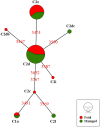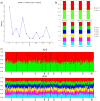Urban ecosystem drives genetic diversity in feral honey bee
- PMID: 36271012
- PMCID: PMC9587283
- DOI: 10.1038/s41598-022-21413-y
Urban ecosystem drives genetic diversity in feral honey bee
Abstract
Urbanization can change biodiversity in both directions, positive and negative, and despite the rising global trend of urban beekeeping, little is known about the impact of urbanization on the genetic diversity of honey bees. We investigate how urbanization affects the genetic variability of feral and managed honey bee colonies that are spread throughout the entire city, even in highly urban areas, through genetic analysis of 82 worker bees. We found convincing evidence of high genetic differentiation between these two groups. Additionally, by comparing city samples with 241 samples from 46 apiaries in rural parts of the country, variations in mitochondrial tRNAleu-cox2 intergenic region and microsatellite loci indicated that feral colonies have distinct patterns of genetic diversity. These results, with evidence that feral honey bees find niches within highly modified and human-dominated urban landscapes, lead us to conclude that urbanization is a driver of the genetic diversity of feral honey bees in the city.
© 2022. The Author(s).
Conflict of interest statement
The authors declare no competing interests.
Figures






References
-
- United Nations, Department of Economic and Social Affairs & Population Division. World Urbanization Prospects: The 2018 Revision (ST/ESA/SER.A/420). (United Nations, 2019).
-
- Wei YD, Ewing R. Urban expansion, sprawl and inequality. Landsc. Urban Plan. 2018;177:259–265. doi: 10.1016/j.landurbplan.2018.05.021. - DOI
-
- Fahrig L. Effects of habitat fragmentation on biodiversity. Annu. Rev. Ecol. Evol. Syst. 2003;34:487–515. doi: 10.1146/annurev.ecolsys.34.011802.132419. - DOI
Publication types
MeSH terms
Substances
LinkOut - more resources
Full Text Sources
Research Materials

